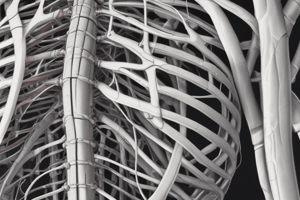Podcast
Questions and Answers
What is the primary mechanism of injury associated with rib fractures?
What is the primary mechanism of injury associated with rib fractures?
- Thermal injury
- Blunt force trauma (correct)
- Penetrating trauma
- Electrical shock
Which of the following symptoms is least likely associated with rib fractures?
Which of the following symptoms is least likely associated with rib fractures?
- Pain with laughing
- Shortness of breath after impact
- Dyspnea
- Nausea and vomiting (correct)
What should be prioritized if a patient with suspected rib fractures shows audible respiratory changes?
What should be prioritized if a patient with suspected rib fractures shows audible respiratory changes?
- Confirm open and clear airways (correct)
- Transport to the hospital without any assessment
- Restrict movement and apply ice
- Provide NSAIDs immediately
In the context of rib fractures, which condition indicates a potential for ineffective oxygen exchange?
In the context of rib fractures, which condition indicates a potential for ineffective oxygen exchange?
Which management strategy is appropriate when dealing with rib fractures that are not traumatic?
Which management strategy is appropriate when dealing with rib fractures that are not traumatic?
Flashcards are hidden until you start studying
Study Notes
Rib Fractures
- Simple rib fractures are not life-threatening, but complex ones can be due to proximity of organs.
- The mechanism of injury (MOI) is typically blunt force trauma.
Signs and Symptoms (S/S)
- Dyspnea (shortness of breath)
- Restricted breathing or pain with breathing
- Pain with laughing, sneezing, or coughing
- Shortness of breath after impact
- Tenderness to palpation (TTP)
- Crepitus (grating or crunching sensation)
- Muscles guarding (muscle tension to protect the area)
Assessment
- Note respiration rate
- Observe the rise and fall of the chest
- Provide oxygen if needed
- Ensure a clear airway
Complications
- Beware of internal bleeding due to penetrating injuries to the lungs, spleen, liver, or kidney
Risk Factors
- Osteoporosis
- Stress fractures
Management
- Palpate with protective equipment to avoid exacerbating pain
- Confirm open and clear airways (audible respiratory changes)
- Provide oxygen if needed
- Administer NSAIDs for pain management
- Apply an ace bandage for non-contact (to avoid pneumonia development)
- Pull from participation if contact sport
Transport Considerations
- Flail chest: ineffective oxygen exchange, difficulty breathing, suspected organ damage
Studying That Suits You
Use AI to generate personalized quizzes and flashcards to suit your learning preferences.




